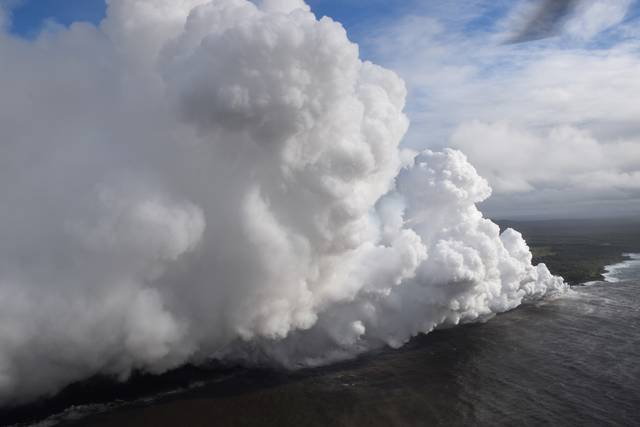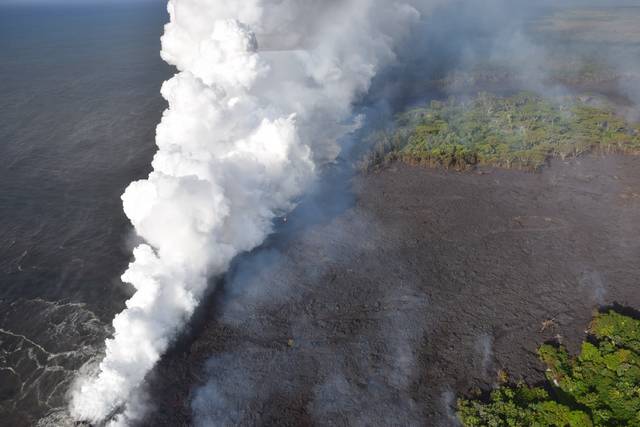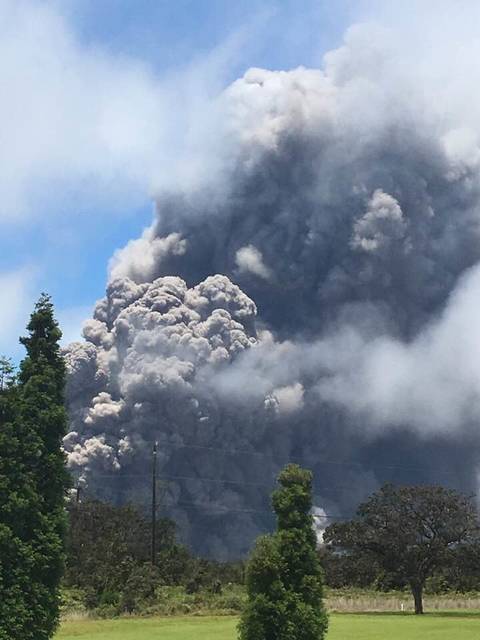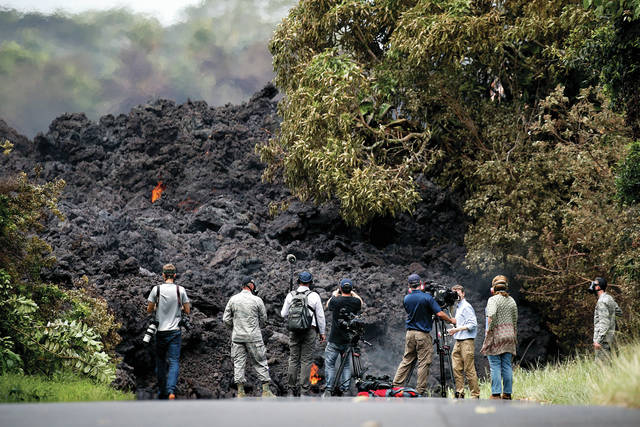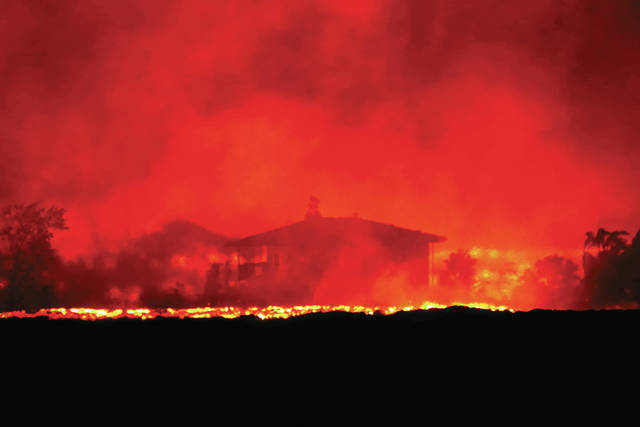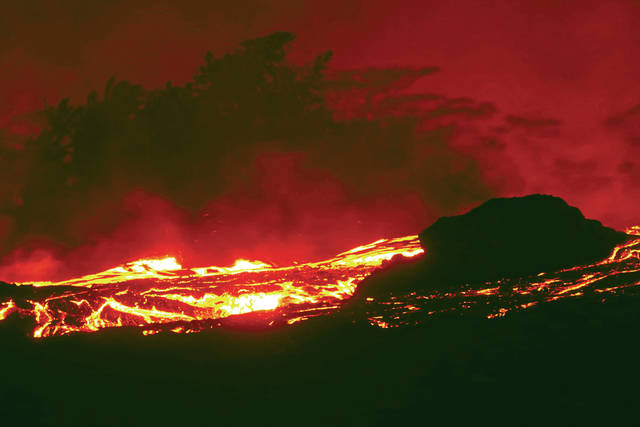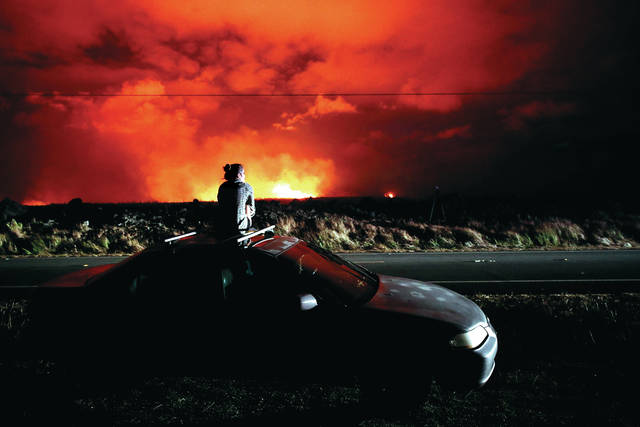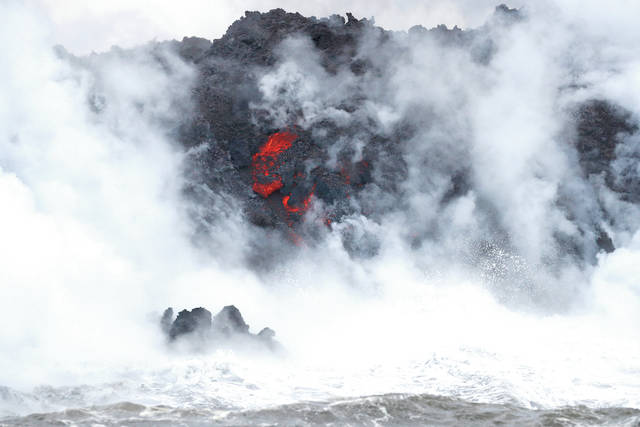Gov. David Ige returned to the Big Island on Sunday for an update about the emergency situation in lower Puna after lava from Kilauea volcano crossed Highway 137 and entered the ocean Saturday night.
During an afternoon press conference, Ige said planners connected to Joint Task Force 50, comprised of Hawaii National Guard and active duty military personnel, are “looking at working with the helicopter assets at Pohakuloa” Training Area in the event highways in lower Puna are completely cut off by lava.
“I did reach out earlier to (U.S. Pacific Command) to talk about needing other assets that would be here in the area …,” the governor said. “If that should occur, we definitely will have access to whatever helicopter assets we would need to do a helicopter evacuation.
“… We’re looking at making sure we identify what that scenario would look like, if we have to make a big mass evacuation.”
Ige said he’s “committed to keeping our transportation routes available to the public, looking at (Government) Beach Road and other temporary kinds of connections to ensure that people would have access in and out of the area.”
“Clearly, some roads are in better conditions than others, I mean, as temporary bypass roads,” he said. “… We want to … ensure the safety of the public, but we know that they need to have access to the area for their lives to return to some form of normalcy.”
Earlier in the day, Cheryl Chipman of the National Park Service said the federal agency, the state Department of Transportation and other government agencies are planning “to prepare the Chain of Craters Road as an evacuation route if Highways 130 and 137 are going to be cut off.”
“The estimate of how long it will take to get through the 0.7 miles of solidified lava on that road is anywhere from two to four weeks,” Chipman said.
Ige said efforts continue to cool down and cap wells at the Puna Geothermal Venture power plant, which is less than a mile away from recent eruptive activity.
“We are mitigating the risk to the geothermal plant,” he said. “… We want to protect the people as best as we can.”
The governor also said he’s concerned about the potential for people who get too close to the lava ocean entry points to inhale “laze,” a noxious gas containing steam, hydrochloric acid and small particles of volcanic glass.
“I want to make sure that people stay away from the area where the lava is entering the ocean,” Ige said.
Hawaiian Volcano Observatory spokeswoman Janet Babb said earlier in the day the effects of laze are dependent upon “the amount of lava going into the ocean and the wind direction and how strong the wind is.”
“Given the vigor of the ocean entry, the amount of lava going into the ocean, and the wind direction, we estimate that the effects could reach as far as 15 miles downwind,” Babb said Sunday. “… Now, if the wind were to stop blowing, it could spread out more like a pancake. (But) with the wind, the effects will be downwind.”
Babb said a store-bought respirator can stop the inhalation of glass particles from laze, but the device won’t filter out hydrochloric acid.
HVO also reports that sulfur dioxide emissions recently tripled.
National Weather Service meteorologist Derek Wroe said current wind patterns are moderate northeasterlies or trades, which are forecast to continue for the next few days.
County Civil Defense Administrator Talmadge Magno said he knows people are attempting to get a look at lava entering the ocean, but urged them to stay away because of the laze.
“It could be a long-term health hazard … from the glass particles in your lungs, because the particles, they’re there forever,” Magno said.
The U.S. Coast Guard said Sunday it began enforcing a “lava entry safety zone” of 300 meters in all directions for the navigable waters surrounding the ocean entry of the lava near MacKenzie state park.
U.S. Geological Survey volcanologist Wendy Stovall said a ground crack opened in the “main eastern channel” of the fissure 20 complex.
“Lava is flowing down into the hole in the ground, and we don’t know exactly where that lava is going, nor do we know where that lava might crop up or if it will ever crop up again. There is also a hole that lava is flowing into on the westernmost side of that fissure complex,” Stovall said. “… We did see the same type of thing during the Kamoamoa eruption in 2011. And the lava that was pouring into the ground never reappeared at the surface.”
According to Stovall, lava samples from fissure 17 contain andesite, a rock not usually found in Hawaii volcanic eruptions. She said the rock’s presence could indicate that fissure’s lava could have been from magma stored underground from before the 1955 eruption, perhaps from the 1924 eruption or even an eruption in 1840.
HVO geophysicist Jim Kauahikaua said there were two summit explosions at Halema‘uma‘u during the weekend — one at about 4 p.m. Saturday and another at about noon Sunday.
“Both of them ejected ash about two miles above sea level — relatively small compared to the one last Thursday that ejected stuff up to 30,000 feet,” Kauahikaua noted. “We obviously can’t see down there. We haven’t been in the crater to see what debris can tell us about the explosions. So we’re still speculating that it has to do with, you know, rockfalls into the crater plugging it up, and it’s either gas pressure or steam blasts … that are ejecting all that off and rock dust out.”
Volcano resident Ken Boyer shot a Facebook Live video from Volcano Golf Course at midday Sunday and noted the “rotten egg” smell associated with sulfur dioxide as an ash plume rose from the crater explosion.
“It stinks,” Boyer said. “When you live in Volcano, you get used to that.”
At the time of both summit eruptions, HVO seismographs recorded 4.9-magnitude earthquakes.
Highway 137 remains closed between Kamaili Road and Pohoiki Road, and Kamaili Road is closed to all through traffic.
The Department of Water Supply says an emergency water restriction is still in effect for customers between Kapoho and Pohoiki. The flow that crossed Pohoiki Road cut off water supply to residents.
Two water tankers are providing public drinking water access to residents and visitors in Vacationland and Kapoho Beach Lots.
Magno said the next community meeting is scheduled for 5:30 p.m. Tuesday at the Pahoa High School gym.
“It’ll be an opportunity for the folks to come meet us and hear the updates … different programs that we have available for them — and, hopefully, answer their questions,” he said.
For an updated map of the lava activity, which started May 3 in lower Puna, visit www.hawaiicounty.gov/2018-lava-map.
Email John Burnett at jburnett@hawaiitribune-herald.com.









